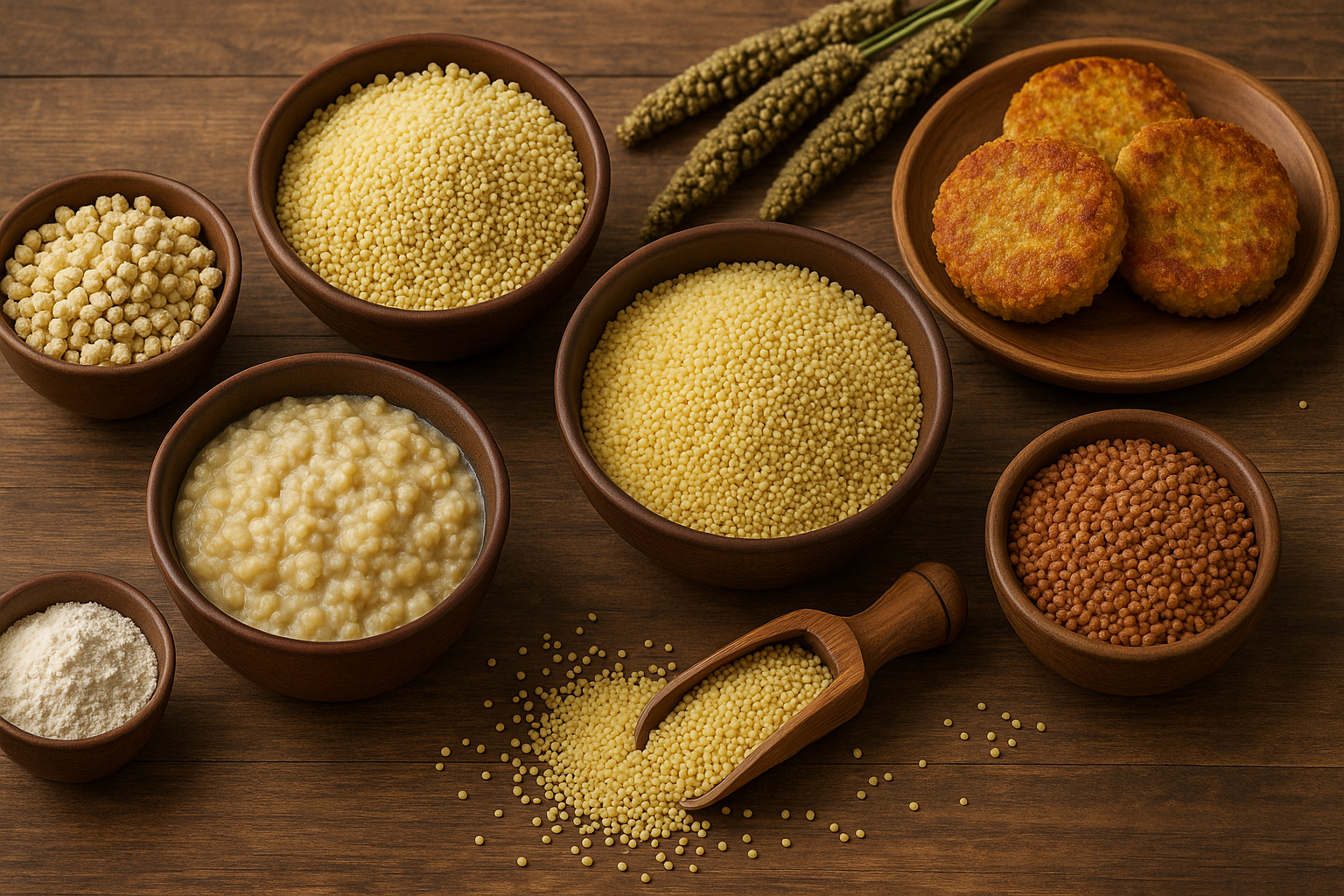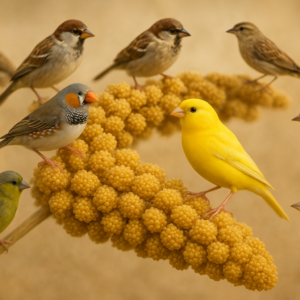Ancient grains are making a comeback, and millets lead this nutritional revolution. These small-seeded grains have sustained populations across Asia and Africa for thousands of years. Today, health-conscious consumers worldwide recognize what traditional communities have known all along: millets offer remarkable health advantages that modern diets desperately need.
Millets earn their nickname “Nutricereals” thanks to their abundant minerals and vitamins. As agricultural product specialists at CMS Industries understand, these climate-resilient crops provide both nutritional security and environmental sustainability. Here is why you should consider adding these powerhouse grains to your daily meals.
What Makes Millets Nutritionally Superior
Before diving into specific health advantages, let’s understand what sets these grains apart. Millets contain 60-70% carbohydrates, 3.5-5.2% fat, and 7.52-12.1% protein. But their real power lies in their diverse nutrient profile.
These grains provide calcium (10-348 mg/100g), iron (2.2-17.7 mg/100g), zinc (0.4-2.8 mg/100g), and phosphorus (189-293 mg/100g). Compare that to refined grains and you’ll see why nutrition experts champion these ancient foods.
1. Regulates Blood Sugar Levels Naturally
Managing blood sugar becomes easier when you choose the right foods. Studies show millets can reduce fasting blood sugar by 11.8% and post-meal glucose by 15.1%. This happens because millets release glucose slowly into your bloodstream.
The secret? Millets rank lower on the glycemic index than many other grains, raising blood sugar gradually rather than in quick spikes. For people managing diabetes or those wanting to prevent it, this steady energy release makes a real difference.
Research involving hundreds of patients showed that a millet-based diet lowered hemoglobin A1C levels from 8.37 to 6.77. These results speak louder than any marketing claim.
2. Supports Heart Health and Reduces Cholesterol
Your heart deserves the best care, and millets deliver on this promise. Millets contain soluble fiber that traps fat in your gut and can lower cholesterol levels in your blood. This natural mechanism helps protect against cardiovascular disease.
The high magnesium content in millets plays a role in regulating blood pressure, which reduces the risk of heart attacks and strokes. When CMS Industries sources quality grains from farmers, they prioritize these nutrient-dense varieties that offer real health protection.
Several clinical trials confirm these benefits. Seventeen studies out of a systematic review showed general reductions in blood sugar levels, serum cholesterol, and serum triglycerides in patients who consume low glycemic index foods like millets.
3. Promotes Digestive Wellness
A healthy gut forms the foundation of overall wellness. The insoluble fiber in millets acts as a prebiotic, supporting good bacteria in your gut. This friendly bacteria colony helps you absorb nutrients better and strengthens your immune system.
The fiber does more than feed beneficial microbes. Fiber adds bulk to your stool, helping keep you regular and reducing your risk of colon cancer. These daily benefits add up to long-term digestive health.
4. Provides Gluten-Free Nutrition
For people with celiac disease or gluten sensitivity, finding nutritious alternatives can be challenging. Millets are naturally gluten-free, making them an excellent choice for people who have celiac disease or follow a gluten-free diet.
You don’t have to sacrifice nutrition when avoiding gluten. Millets have been found to be helpful for celiac disease, cardiovascular disease, and diabetes mellitus. This versatility makes them perfect for diverse dietary needs.
5. Strengthens Bones with High Calcium Content
Building strong bones requires consistent calcium intake. Finger millet is one of the richest vegetarian sources of calcium (300-350 mg/100g), which is almost 10 times that in wheat. This makes it particularly valuable for vegetarians and vegans.
Growing children, pregnant women, and older adults all benefit from this calcium boost. As agricultural suppliers at CMS Industries work with various grain producers, they recognize the special nutritional role finger millet plays in addressing calcium deficiency.
Discover how it helps you stay fit with Yellow Millet Benefits for Weight Loss — please read this blog!
6. Delivers Powerful Antioxidant Protection
Your body fights free radicals every day. Millets are rich in antioxidants such as quercetin, curcumin, and ellagic acid that protect the body against oxidative stress and inflammation. These compounds work like shields, defending your cells from damage.
Millet varieties contain bioactive products like protocatechuic acid, vanillic acid, catechin, ferulic acid, and kaempferol. These tongue-twisting names represent powerful health protectors that fight aging and disease.
Millets contain phytochemicals that impart therapeutic properties for various disorders and diseases, giving them nutraceutical value. This transforms simple grains into functional foods.
7. Supports Weight Management Goals
Maintaining a healthy weight becomes easier with the right food choices. A single serving of millet provides around 4 grams of fiber, which is substantial for digestive health and blood sugar control. This fiber keeps you feeling satisfied longer.
The slow-digesting nature of millets means you experience fewer hunger pangs between meals. You naturally eat less when your body feels truly nourished. This makes millets perfect for anyone working toward weight management goals.
8. Boosts Iron Levels and Prevents Anemia
Iron deficiency affects millions worldwide, particularly women and children. Pearl millet has the highest iron content of 5-6.5 mg/100g. This makes it a powerful ally against anemia.
The iron from millets comes in a form your body can use. Supplementary benefits include treatment of anemia and calcium deficiency especially for pregnant women and young children. This natural approach to addressing nutritional deficiencies works with your body, not against it.
9. Enhances Skin and Nerve Function
Your skin needs proper nutrition to stay healthy. Millet is rich in niacin, which is important for healthy skin and organ function. B vitamins in millets support cell division and nerve health.
Dark-colored millet grains contain beta-carotene, which converts to vitamin A, helps your body fight free radicals, and supports your immune system. This means better skin, sharper vision, and stronger immunity from one simple food swap.
10. Offers Sustainable Energy Throughout the Day
Unlike refined grains that cause energy crashes, millets provide steady fuel. The complex carbohydrates break down slowly, releasing glucose gradually into your bloodstream. This prevents the spike-and-crash cycle that refined grains trigger.
Millets offer a significant source of magnesium, phosphorus, manganese, and B vitamins that play a role in energy metabolism. When CMS Industries supplies quality agricultural products, they understand that sustainable energy starts with smart food choices.
Different Types of Millets and Their Unique Benefits
Not all millets are created equal. Each variety brings something special to your plate:
- Pearl Millet (Bajra): Leads in iron content and protein. Perfect for strengthening blood health and building muscle.
- Finger Millet (Ragi): Champion of calcium content. Best choice for bone health and preventing osteoporosis.
- Foxtail Millet: Rich in dietary fiber and B vitamins. Excellent for digestive health and energy production.
- Sorghum (Jowar): Packed with antioxidants and has anti-inflammatory properties. Great for overall wellness.
- Barnyard Millet: Lowest in carbohydrates among millets. Ideal for weight management and diabetes control.
How to Include Millets in Your Daily Diet
Making the switch to millets is easier than you might think. Start small and gradually increase your intake:
- Breakfast: Replace your morning oats with millet porridge topped with fresh fruits and nuts. Cook millet upma or make millet dosas for a savory start.
- Lunch and Dinner: Substitute rice with cooked millets. Make millet pulao, khichdi, or use it as a base for grain bowls.
- Snacks: Try puffed millets as a crunchy snack. Millet cookies and crackers make healthy alternatives to processed snacks.
- Baking: Use millet flour in rotis, bread, and baked goods. Mix it with other flours for better texture.
CMS Industries works with farmers across India to ensure quality grains reach consumers. Their commitment to agricultural excellence means you get nutritious millets that retain all their natural benefits.
Simple Tips for Cooking Perfect Millets
Getting the texture right makes all the difference:
- Rinse millets thoroughly before cooking to remove any debris
- Use a 2.5:1 water-to-millet ratio for fluffy grains
- Toast dry millets in a pan for 3 minutes before cooking to enhance flavor
- Cook for 25-30 minutes until water is absorbed and grains are tender
- Let them rest for 5 minutes after cooking for best texture
Are There Any Precautions to Consider?
While millets offer numerous benefits, balance remains key. Millets contain anti-nutritional factors like phytates, oxalates, and tannins that can inhibit the absorption of essential minerals. You can reduce these compounds through proper preparation.
Soaking millets for a few hours before cooking helps reduce phytic acid. Cooking thoroughly also breaks down these compounds. Don’t let this concern stop you from enjoying millets. The benefits far outweigh these minor considerations when you prepare them correctly.
People with thyroid conditions should consume certain millets in moderation and consult their healthcare provider. Everyone’s nutritional needs differ, so listen to your body and adjust accordingly.
The Environmental Advantage
Beyond personal health, choosing millets helps the planet. These hardy crops grow in harsh conditions with minimal water and fertilizer. They thrive where other crops fail, making them perfect for sustainable agriculture.
CMS Industries recognizes this environmental advantage. By supporting millet cultivation, they help farmers adapt to climate change while providing nutritious food options. This creates a win-win situation for health and sustainability.
Making the Switch: Your Action Plan
Ready to experience these benefits? Here is your step-by-step guide:
- Week 1-2: Replace one meal per day with millets. Start with breakfast porridge or millet rotis.
- Week 3-4: Increase to two meals per day. Try millet rice for lunch and millet dosas for dinner.
- Month 2 onwards: Experiment with different varieties. Each type offers unique flavors and nutrients.
Track how you feel. Most people notice improved energy levels, better digestion, and steadier blood sugar within the first month.
Curious to learn what is yellow millet and why it’s so nutritious? — please read this blog!
Conclusion
The evidence is clear: millets deserve a prominent place in modern diets. From blood sugar control to heart health, from bone strength to digestive wellness, these ancient grains deliver on multiple fronts. As agricultural experts at CMS Industries work to make quality millets accessible, consumers can confidently make this healthy switch.
Start your millet journey today. Your body will thank you for choosing nutrition over convenience, tradition over trends, and wellness over fleeting food fads. These tiny grains pack enormous potential for transforming your health naturally and sustainably.
Frequently Asked Questions
Q1: Can people with diabetes eat millets daily?
Yes, people with diabetes can safely include millets in their daily diet. The low glycemic index helps control blood sugar levels without causing spikes. Start with small portions and monitor your blood sugar response. Most people find millets help them manage their condition better than refined grains. Consult your healthcare provider about appropriate serving sizes for your specific needs.
Q2: Which type of millet provides the most health benefits?
All millets offer unique advantages, making it hard to pick just one. Finger millet leads for calcium content, pearl millet for iron, and foxtail millet for fiber. The best approach involves rotating different types throughout your week. This ensures you receive a full spectrum of nutrients. CMS Industries supplies various millet types to help consumers access this nutritional diversity.
Q3: How long does it take to see health benefits from eating millets?
Many people notice improved digestion and energy within 1-2 weeks of regular millet consumption. Blood sugar improvements typically show up within 3-4 weeks. Cholesterol and weight changes may take 2-3 months of consistent intake. Remember that individual results vary based on overall diet, lifestyle, and health status. Patience and consistency bring the best outcomes.
Q4: Can children and pregnant women eat millets safely?
Absolutely! Millets provide excellent nutrition for growing children and pregnant women. The high calcium supports bone development, while iron prevents anemia. The protein content aids growth and tissue repair. Start children with simple millet porridge and gradually introduce other preparations. Pregnant women particularly benefit from the folate and iron content. Always introduce new foods gradually and watch for any reactions.
Q5: What is the best time to eat millets for maximum benefits?
You can enjoy millets at any meal, but morning consumption offers particular advantages. Starting your day with millet porridge provides sustained energy throughout the morning. The fiber keeps you satisfied until lunch. For blood sugar management, eating millets at dinner helps prevent nighttime glucose spikes. The key is consistency rather than timing. Choose whatever schedule helps you maintain regular millet consumption.





